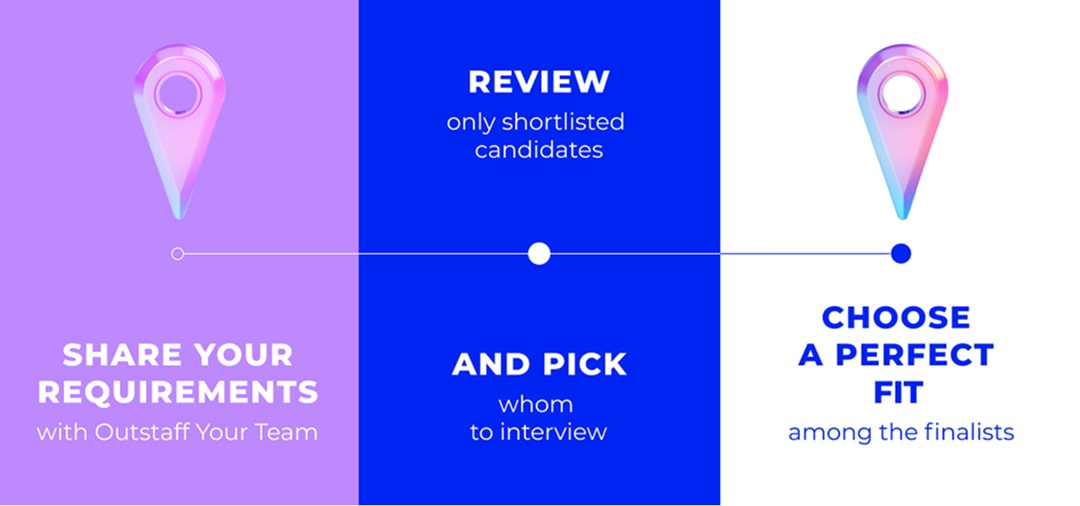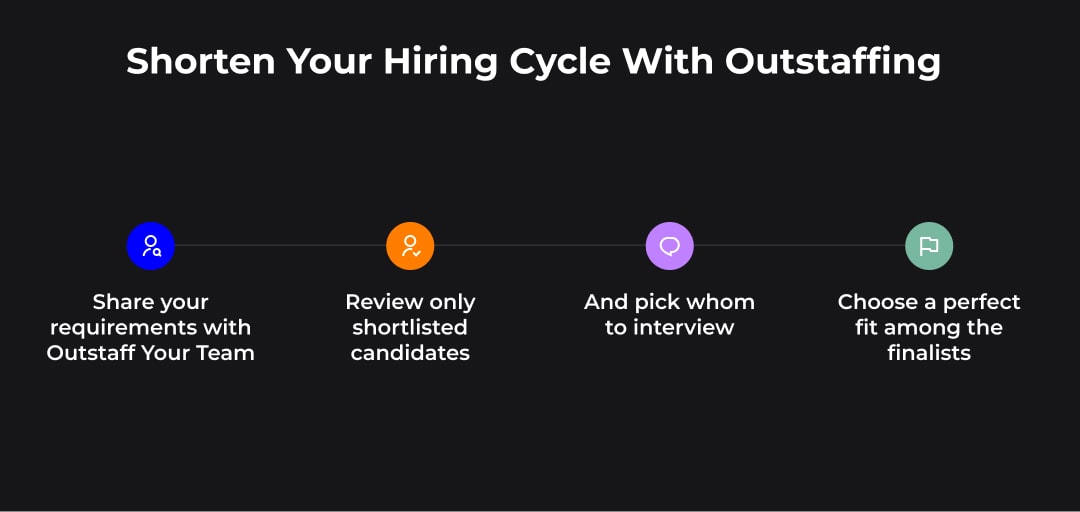Starting a new venture can be exciting, but assembling a strong team of skilled professionals comes first. If you hire software developers who are a good match, you achieve your business goals faster.
About 90% of hiring managers make their final decision intuitively. As a result, team issues are the third most popular reason for a startup failure, after poor product market fit and wrong marketing strategies. Yet, our team follows 6 data-driven steps when spotting the right candidates. It results in 94% of successful hires.
#1. Define Your Needs
A detailed candidate portrait clarifies your requirements and helps avoid costly mishires down the line. Look through the cheat-sheet based on the Outstaff Your Team’s decade of experience. It can become your starting point when you plan to hire a programmer for a startup,
Clarify your tech stack. List the programming languages, frameworks, and platforms your project needs now and in the near future.
Specify roles and responsibilities. Don’t just say “web developer.” Distinguish between front-end, back-end, full-stack, DevOps, and AI/ML roles.

Align with business goals. Tie each role to a specific business outcome for data-driven hiring.
Example: Key Responsibilities for a Front-End Developer
Responsibility
Why It Matters
Build responsive UIs (HTML, CSS, JS)
Ensures a seamless user experience
Optimize cross-browser performance
Maximizes accessibility and reach
Integrate design mockups or wireframes into functional web page
Accelerates product iteration
Focus on experienced players. They know how to avoid common pitfalls such as overengineering or chasing unproven technologies.
To make your hiring investment predictable, focus on candidates’ years of commercial experience with your preferred technologies.
Look for vision alignment and flexibility. Your first programmer shouldn’t just execute tasks, they need to see the bigger picture and make smart technical decisions.
At Ray, our early development team thrived because they viewed constraints as creative opportunities. One moment, they would be shipping a feature, and the next, they might be debugging analytics or joining a call with a designer. If your first hire requires a rigid structure or a narrow job description, it could hinder your progress.
Seek technical translators. The ideal candidate should communicate clearly with non-technical stakeholders.
I often ask candidates to describe a feature they built to someone who has no tech background. Most of the candidates flounder, either using jargon, leaving out context, or assuming too much.
However, your first hire is likely to be the one speaking with customers, investors, and partners. They need to make statements like, "This feature will take two weeks of backend work," instead of, "Our DB architecture doesn't support that." Lacking clarity can lead to misalignment and ultimately broken trust.
Consider future growth. Think beyond immediate needs. Hire someone who can scale with your startup, learn new tools, and adapt to upcoming challenges.
I believe, you’ve got the main idea — set clear expectation before a hiring campaign starts.
Request a talent market analysis for your project. Discover current rates, candidate availability, and best-fit hiring models tailored to your budget.
Book a consultation
#2. Define What Compensation To Offer
When you're competing for top programming talent, the question arises: how to hire programmers for a startup having a budget which is far from MAANG companies? Actually, a competitive compensation package should be relevant to the target specialists rather than enormous.
Some business owners regret they haven’t conducted the talent market research for the special position before hiring programmers for a startup. But you will not be one of them, if you look for reputable global and local job boards, company websites, and professional networking platforms where software developer positions are frequently posted. Some popular options include LinkedIn, Indeed, Glassdoor, Stack Overflow Jobs, and specialized tech job boards.
Why is market research essential?
Expand or narrow the area of responsibility based on the existing candidates’ profiles.
Set different compensations depending on the type of market. IT salaries vary widely by geography.
Adjust the hourly rates to the required experience. Yet, be aware that ultra-low-cost may lack experience, work on multiple projects simultaneously, or produce code that requires costly fixes later.

#3. Showcase Your Startup's Unique Selling Points
When hiring a programmer for a startup, remember, not only you are picking candidates, they're evaluating your startup too. Highlight what sets your venture apart. Is it a flexible work environment, a culture of innovation, or the potential for rapid career growth? Talented programmers often have multiple options, so make sure your startup has something remarkable, and we are sure that it has.
Developers are careful about joining startups because of relative unpredictability, high workload and possible burnout in the end. At the same time, a lot of them value the startup environment for its democracy, an opportunity to work on some game-changing product, and a potentially powerful asset to their portfolio. So, showcase what impact your product can bring to the niche you specialize in. It also will be just to the point, if you can provide your new hires with additional perks like remote work options and a stake in the company's success through equity or stock options.
If you have any doubts related to remote computer programmers, take a look at the benefits of remote tech hiring.
One more point of success is your brand reputation. 70% of jobseekers make their investigations before applying, and it impacts their decision to accept your offer. You should check if your profiles on social media platforms and reviews from the existing team members on the job boards look attractive.
#4. Craft an Engaging Job Description
Writing a job description that resonates with top programming talent is not so tricky if you have followed the 3 previous steps. Thus, you can create an appealing vacancy announcement combining your requirements and your insight into market trends.
Outline your startup's mission and vision;
Provide the full list of technical skills you require;
Mention the compensation package and opportunities your startup can bring to their life;
Set the expectations about the weekly and monthly performance and how it will change over time.
Add a couple of words about your project team and company culture.
Carefully review and adjust AI-generated descriptions to make sure they match your real needs and don’t miss important details.
Polish your tone voice. It should reflect the communication style typical for your company. Thus, you give the first impression, aligning with the next interactions. If you are unsure about the writing style, stick to the generic language, as 75% of candidates prefer job descriptions which are neither too casual nor too formal.

Plus, note that 48% of candidates will be thankful for informing them about the interview stages right in the job description. In general, openness and clarity in each sentence help stand out from the crowd.
#5. Leverage Online Platforms
It is hard to imagine how to scale a tech team in the 21st century without entering online platforms where tech professionals crowd. Serf through the websites like LinkedIn and tech-specific job boards.
70% of candidates seek new roles passively, according to the report by LinkedIn. They don’t notify anybody they are interested in vacancies anyhow, but review job openings from time to time. Altogether, 90% of specialists prefer the company representative to contact them rather than start conversations themselves.
Conclusion? Engage in discussions and network with developers to spread the word about your startup's job opening. Actively participating in online tech communities can help you identify programmers who are passionate about their craft.
GitHub, the popular platform for hosting and reviewing code, boasts over 56 million developers. It's a goldmine for discovering top coding talent. Your constant presence in the IT environment makes hiring a programmer much easier, as you always have a couple of bright heads on your contact list.
#6. Conduct Structured Interviews
How to hire a programmer who will not leave in a couple of months? Interviews are the make-or-break phase of hiring programmers for your startup. Plan an interview process that discovers technical skills and cultural fit. Consider using coding tests, pair programming sessions, and behavioral questions to gauge a candidate's problem-solving abilities and how well they'd integrate into your team.
Google is known for its rigorous hiring process, which once included questions like “How many golf balls can fit in a school bus?”. While your questions don't need to be that quirky, focusing on problem-solving can reveal a lot about a candidate's approach to challenges.
Connect with global tech talent now and gain access to a curated shortlist of programmers equipped with the skill sets your project demands. No need to write job descriptions or pre-vet candidates yourself.
Submit your requirements
When Hiring, Reputation is a Success Factor
How to hire programmers for a startup and save time? Delegate hiring to survive in the conditions of intense growth. If you want to sleep easy knowing your hiring strategy delivers results, we recommend you follow this checklist when choosing an HR Partner for your startup. Ideally, when an HR team:
Is seasoned in hiring for IT, as that field suggests diving deeply into the specialized roles and working conditions;
Provides you with a list of mature candidates for your position, so that you could pick the most suitable ones;
Arrange regular well-being check-ins with your startup programmers to prevent their burnout;
Takes over any local compliance when you decide to extend your hiring geography.
Enables flexible staffing (contract, part-time, or remote hires). Hiring only when and where needed is one of the best ways to control costs.

In case you consider partnership with us, we gather all the input necessary for a vacancy launch during a Discovery call. Then, we approve the interview stages, hand pick, and interview developers. Once, we have defined the best matches, hiring managers interview the top 5 candidates and make a final decision. After that, we hire programmers for the startup, onboard them, and take care of payrolls and talent retention.
FAQ
How do I decide between hiring a freelancer or a full-time programmer for my startup?
If you're building your startup’s core product, go with a full-time programmer—they’ll be more invested, available daily, and better suited for long-term development and maintenance. Choose a freelancer if you need help with a clearly defined, time-limited task like building an MVP feature or fixing bugs, and don’t need ongoing involvement.
How much does it cost to hire a programmer for a startup?
The cost of hiring a programmer for a startup varies based on location, tech stack, and experience. Developers in regions like Silicon Valley or New York typically command higher rates than equally skilled talent in Eastern Europe, Latin America, or Asia. To get a clearer picture of what you might pay for roles like full-stack, mobile, or machine learning developers, check out our hourly rate breakdown by role and region.
How long does it usually take to hire a programmer for a startup?
Hiring a programmer for a startup through traditional channels can take up to 8 weeks for the most challenging or highly specialized positions and typically averages 4–6 weeks for most roles. Time adds up because of lengthy sourcing, screening, and negotiation processes.
With Outstaff Your Team’s fast-hiring outstaffing model, we dramatically reduce these timelines. Thanks to our pre-vetted talent pool and streamlined workflows, we can present you with qualified junior candidates in as little as 5 days. For more complex or senior roles, our average hiring time is just 21 days (about 3 weeks), less than half the industry norm.
After your discovery call, you’ll receive shortlisted, thoroughly vetted candidate profiles matching your criteria. This means you can skip the time-consuming steps of writing job descriptions, sourcing, and screening, while we handle negotiations to ensure a fast, frictionless process from start to finish.
Ann Kuss is the CEO at Outstaff Your Team. After 11 years of expertise in building remote tech teams for startup unicorns and global tech brands, Ann decided to lead a new venture aiming to reinvent the way international tech teams scale. Throughout her career, Ann hired specialists for countless tech positions from more than 17 countries on all major continents. Ann graduated from Kyiv-Mohyla business school, is an MIM Kyiv alumna, and regularly takes part in mentorship programs for junior tech talents. Ann actively promotes knowledge sharing and curates Outstaff Your Team blog strategy, preferring topics that solve practical needs of IT leaders. She believes that structuring business flows (including hiring) is a well-planned journey with predictable and successful outcome.






